Discover 35 hidden attractions, cool sights, and unusual things to do in Jerusalem (Israel). Don't miss out on these must-see attractions: Western Wall, Yad Vashem, and Temple Mount. Also, be sure to include Dome of the Rock in your itinerary.
Below, you can find the list of the most amazing places you should visit in Jerusalem (Jerusalem).
Table of Contents
Western Wall
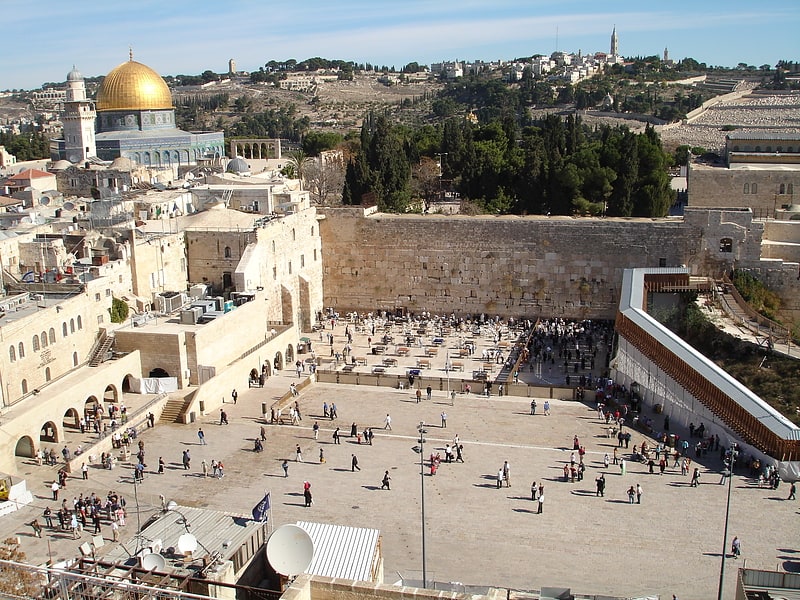
Also known as: הכותל המערבי
Ancient sacred site for Jewish prayer. The Wailing Wall or Western Wall, known in Islam as the Buraq Wall, is an ancient limestone wall in the Old City of Jerusalem. It is a relatively small segment of a far longer ancient retaining wall, known also in its entirety as the "Western Wall". The wall was originally erected as part of the expansion of the Second Jewish Temple begun by Herod the Great, which resulted in the encasement of the natural, steep hill known to Jews and Christians as the Temple Mount, in a huge rectangular structure topped by a flat platform, thus creating more space for the Temple itself, its auxiliary buildings, and crowds of worshipers and visitors.
In one of several varying Muslim traditions, it is the site where the Islamic Prophet Muhammad tied his winged steed, al-Buraq, on his Isra and Mi'raj to Jerusalem before ascending to paradise, and constitutes the western border of al-Haram al-Sharif, the Noble Sanctuary of the Al-Aqsa Mosque.
The Western Wall's holiness in Judaism is a result of its proximity to the Temple Mount. Because of the Temple Mount entry restrictions, the Wall is the holiest place where Jews are permitted to pray, though the site of the Holy of Holies, the most sacred site in the Jewish faith, lies behind it. The original, natural, and irregular-shaped Temple Mount was gradually extended to allow for an ever-larger Temple compound to be built at its top. This process was finalized by Herod, who enclosed the Mount with an almost rectangular set of retaining walls, made to support the Temple platform and using extensive substructures and earth fills to give the natural hill a geometrically regular shape. On top of this box-like structure, Herod built a vast paved platform that surrounded the Temple. Of the four retaining walls, the western one is considered closest to the former Holy of Holies, which makes it the most sacred site recognized by Judaism outside the previous Temple Mount platform.
Just over half the wall's total height, including its 17 courses located below street level, dates from the end of the Second Temple period, and is commonly believed to have been built by Herod the Great starting in 19 BCE, although recent excavations indicate that the work was not finished by the time Herod died in 4 BCE. The very large stone blocks of the lower courses are Herodian, the courses of medium-sized stones above them were added during the Umayyad period, while the small stones of the uppermost courses are of more recent date, especially from the Ottoman period.
The term Western Wall and its variations are mostly used in a narrow sense for the section traditionally used by Jews for prayer; it has also been called the "Wailing Wall", referring to the practice of Jews weeping at the site over the destruction of the Temples. During the period of Christian Roman rule over Jerusalem (ca. 324–638), Jews were completely barred from Jerusalem except on Tisha B'Av, the day of national mourning for the Temples, and on this day the Jews would weep at their holy places. The term "Wailing Wall" was thus almost exclusively used by Christians, and was revived in the period of non-Jewish control between the establishment of British Rule in 1920 and the Six-Day War in 1967. The term "Wailing Wall" is not used by religious Jews, and increasingly not by many others who consider it derogatory.
In a broader sense, "Western Wall" can refer to the entire 488-metre-long (1,601 ft) retaining wall on the western side of the Temple Mount. The classic portion now faces a large plaza in the Jewish Quarter, near the southwestern corner of the Temple Mount, while the rest of the wall is concealed behind structures in the Muslim Quarter, with the small exception of an 8-metre (26 ft) section, the so-called Little Western Wall. The segment of the western retaining wall traditionally used for Jewish liturgy, known as the "Western Wall" or "Wailing Wall", derives its particular importance to it having never been fully obscured by medieval buildings, and displaying much more of the original Herodian stonework than the "Little Western Wall". In religious terms, the "Little Western Wall" is presumed to be even closer to the Holy of Holies and thus to the "presence of God" (Shechina), and the underground Warren's Gate, which has been out of reach for Jews from the 12th century till its partial excavation in the 20th century, even more so.
Whilst the wall was considered Muslim property as an integral part of the Haram esh-Sharif and waqf property of the Moroccan Quarter, a right of Jewish prayer and pilgrimage existed as part of the Status Quo. This position was confirmed in a 1930 international commission during the British Mandate period.
The earliest source mentioning this specific site as a place of Jewish worship is from the 17th century. The previous sites used by Jews for mourning the destruction of the Temple, during periods when access to the city was prohibited to them, lay to the east, on the Mount of Olives and in the Kidron Valley below it. From the mid-19th century onwards, attempts to purchase rights to the wall and its immediate area were made by various Jews, but none was successful. With the rise of the Zionist movement in the early 20th century, the wall became a source of friction between the Jewish and Muslim communities, the latter being worried that the wall could be used to further Jewish claims to the Temple Mount and thus Jerusalem. During this period outbreaks of violence at the foot of the wall became commonplace, with a particularly deadly riot in 1929 in which 133 Jews and 116 Arabs were killed, with many more people injured. After the 1948 Arab–Israeli War the eastern portion of Jerusalem was occupied by Jordan. Under Jordanian control Jews were completely expelled from the Old City including the Jewish Quarter, and Jews were barred from entering the Old City for 19 years, effectively banning Jewish prayer at the site of the Western Wall. This period ended on June 10, 1967, when Israel gained control of the site following the Six-Day War. Three days after establishing control over the Western Wall site, the Moroccan Quarter was bulldozed by Israeli authorities to create space for what is now the Western Wall plaza.[1]
Address: Western Wall Plaza, 97500 Jerusalem
Yad Vashem

Also known as: יד ושם
Holocaust memorial and education center. Yad Vashem is Israel's official memorial to the victims of the Holocaust. It is dedicated to preserving the memory of the Jews who were murdered; honoring Jews who fought against their Nazi oppressors and Gentiles who selflessly aided Jews in need; and researching the phenomenon of the Holocaust in particular and genocide in general, with the aim of avoiding such events in the future.
Established in 1953, Yad Vashem is located on the western slope of Mount Herzl, also known as the Mount of Remembrance, a height in western Jerusalem, 804 meters (2,638 ft) above sea level and adjacent to the Jerusalem Forest. The memorial consists of a 180-dunam (18.0 ha; 44.5-acre) complex containing two types of facilities: some dedicated to the scientific study of the Holocaust and genocide in general, and memorials and museums catering to the needs of the larger public. Among the former there are a research institute with archives, a library, a publishing house, and an educational center, and the International School for Holocaust Studies; among the latter, the Holocaust History Museum, memorial sites such as the Children's Memorial and the Hall of Remembrance, the Museum of Holocaust Art, sculptures, outdoor commemorative sites such as the Valley of the Communities, and a synagogue.
A core goal of Yad Vashem's founders was to recognize non-Jews who, at personal risk and without a financial or evangelistic motive, chose to save Jews from the ongoing genocide during the Holocaust. Those recognized by Israel as Righteous Among the Nations are honored in a section of Yad Vashem known as the Garden of the Righteous Among the Nations.
Yad Vashem is the second-most-visited Israeli tourist site, after the Western Wall, with approximately one million visitors each year. It charges no admission fee.[2]
Address: Har Hazikaron, P.O.B. 3477, 91034 שלם
Temple Mount

Also known as: הר הבית
Hilltop compound of religious sites. The Temple Mount, known to Muslims as the Haram esh-Sharif and the Al-Aqsa Compound, is a hill in the Old City of Jerusalem that for thousands of years has been venerated as a holy site in Judaism, Christianity, and Islam alike.
The present site is a flat plaza surrounded by retaining walls (including the Western Wall) that was built during the reign of Herod the Great for an expansion of the temple. The plaza is dominated by three monumental structures from the early Umayyad period – the al-Aqsa Mosque, the Dome of the Rock and the Dome of the Chain – and four minarets. Herodian walls and gates, with additions from the late Byzantine and early Islamic periods, cut through the flanks of the Mount. Currently, it can be reached through eleven gates, ten reserved for Muslims and one for non-Muslims, with guard posts of Israeli police in the vicinity of each.
According to Jewish tradition and scripture, the First Temple was built by King Solomon, the son of King David, in 957 BCE, and was destroyed by the Neo-Babylonian Empire in 586 BCE; however, no substantial archaeological evidence has verified this. The Second Temple was constructed under the auspices of Zerubbabel in 516 BCE, and was destroyed by the Roman Empire in 70 CE. Orthodox Jewish tradition maintains it is here that the third and final Temple will be built when the Messiah comes. The Temple Mount is the holiest site in Judaism, and is the place Jews turn towards during prayer. Due to its extreme sanctity, many Jews will not walk on the Mount itself, to avoid unintentionally entering the area where the Holy of Holies stood, since according to rabbinical law, there is still some aspect of the divine presence at the site.
Among Muslims, the Mount is the site of one of the three Sacred Mosques, the holiest sites in Islam. Amongst Sunni Muslims, it is considered the third holiest site in Islam. Revered as the Noble Sanctuary, the location of Muhammad's journey to Jerusalem and ascension to heaven, the site is also associated with the Jewish biblical prophets who are also venerated in Islam. Umayyad Caliphs commissioned the construction of the al-Aqsa Mosque and Dome of the Rock on the site. The Dome was completed in 692 CE, making it one of the oldest extant Islamic structures in the world. The Al Aqsa Mosque rests on the far southern side of the Mount, facing Mecca. The Dome of the Rock currently sits in the middle, occupying or close to the area where the Holy Temple previously stood.
In light of the dual claims of Judaism and Islam, it is one of the most contested religious sites in the world. Since the Crusades, the Muslim community of Jerusalem has managed the site through the Jerusalem Islamic Waqf. The Temple Mount is within the Old City, which has been controlled by Israel since 1967. After the Six-Day War, Israel handed administration of the site back to the Waqf under Jordanian custodianship, while maintaining Israeli security control. It remains a major focal point of the Arab–Israeli conflict. In an attempt to keep the status quo, the Israeli government enforces a controversial ban on prayer by non-Muslims.[3]
Dome of the Rock

Also known as: כיפת הסלע
Islamic shrine housing Foundation Stone. The Dome of the Rock is an Islamic shrine located on the Temple Mount in the Old City of Jerusalem. Its initial construction was undertaken by the Umayyad Caliphate on the orders of Abd al-Malik during the Second Fitna in 691–692 CE, and it has since been situated on top of the site of the Second Jewish Temple, which was destroyed by the Romans in 70 CE. The original dome collapsed in 1015 and was rebuilt in 1022–23. The Dome of the Rock is in its core one of the oldest extant works of Islamic architecture.
Its architecture and mosaics were patterned after nearby Byzantine churches and palaces, although its outside appearance was significantly changed during the Ottoman period and again in the modern period, notably with the addition of the gold-plated roof, in 1959–61 and again in 1993. The octagonal plan of the structure may have been influenced by the Byzantine-era Church of the Seat of Mary (also known as Kathisma in Greek and al-Qadismu in Arabic), which was built between 451 and 458 on the road between Jerusalem and Bethlehem.
The Foundation Stone (or Noble Rock) that the temple was built over bears great significance in the Abrahamic religions as the place where God created the world as well as the first human, Adam. It is also believed to be the site where Abraham attempted to sacrifice his son, and as the place where God's divine presence is manifested more than in any other place, towards which Jews turn during prayer. The site's great significance for Muslims derives from traditions connecting it to the creation of the world and the belief that the Night Journey of Muhammad began from the rock at the centre of the structure.
Designated by UNESCO as a World Heritage Site, it has been called "Jerusalem's most recognizable landmark" along with two nearby Old City structures: the Western Wall and the "Resurrection Rotunda" in the Church of the Holy Sepulchre. It is the earliest archaeologically attested religious structure to be built by a Muslim ruler and the building's inscriptions contain the earliest epigraphic proclamations of Islam and of the Islamic prophet Muhammad; the inscriptions proved to be a milestone, as afterward they became a common feature in Islamic structures and almost always mention Muhammad. The Dome of the Rock remains a "unique monument of Islamic culture in almost all respects", including as a "work of art and as a cultural and pious document", according to historian Oleg Grabar.[4]
Address: Temple Mount, Jerusalem
Church of the Holy Sepulchre
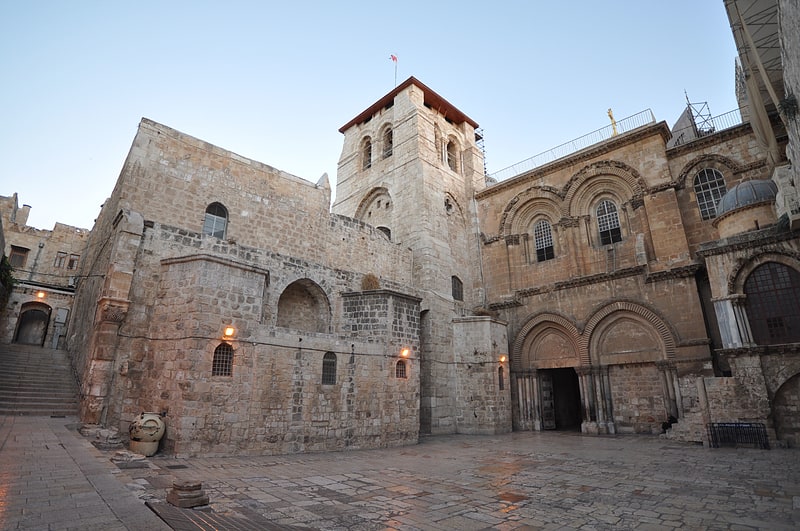
Also known as: כנסיית הקבר
Circa-4th-century Christian chapel. The Church of the Holy Sepulchre is a church in the Christian Quarter of the Old City of Jerusalem. According to traditions dating back to the fourth century, it contains the two holiest sites in Christianity: the site where Jesus was crucified, at a place known as Calvary or Golgotha, and Jesus's empty tomb, where he is believed by Christians to have been buried and resurrected. The tomb is enclosed by a 19th-century shrine called the Aedicula. The Status Quo, an understanding between religious communities dating to 1757, applies to the site.
Within the church proper are the last four stations of the Cross of the Via Dolorosa, representing the final episodes of the Passion of Jesus. The church has been a major Christian pilgrimage destination since its creation in the fourth century, as the traditional site of the resurrection of Christ, thus its original Greek name, Church of the Anastasis ('Resurrection').
Today, the wider complex around the Church of the Holy Sepulchre also serves as the headquarters of the Greek Orthodox patriarch of Jerusalem, while control of the church itself is shared, a simultaneum, among several Christian denominations and secular entities in complicated arrangements essentially unchanged for over 160 years, and some for much longer. The main denominations sharing property over parts of the church are the Greek Orthodox, Roman Catholic, and Armenian Apostolic, and to a lesser degree the Coptic Orthodox, Syriac Orthodox, and Ethiopian Orthodox.[5]
Address: Suq Khan e-Zeit and Christian Quarter Road., Jerusalem
Ben Yehuda Street
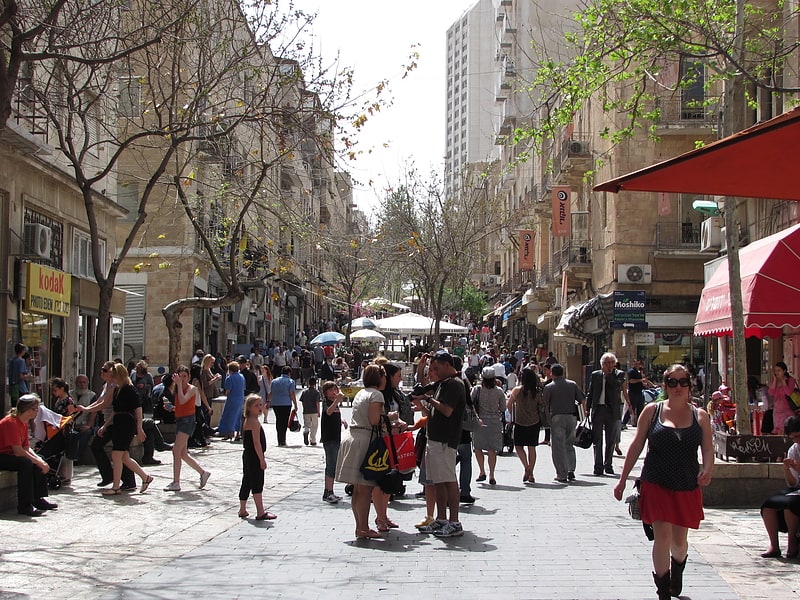
Also known as: רחוב בן-יהודה
Street in Jerusalem, Israel. Ben Yehuda Street, known as the "Midrachov", is arguably the most famous street in Jerusalem, along with Jaffa Road. Ben Yehuda Street joins with Jaffa Road and King George Street in the heart of downtown Jerusalem to form the main Downtown Triangle central business district. Closed to vehicular traffic, the street is now Jerusalem's most popular pedestrian mall. The street runs from the intersection of King George Street east to Zion Square and Jaffa Road. The street is named after the founder of Modern Hebrew, Eliezer Ben-Yehuda.[6]
Address: Ben Yehuda St, Jerusalem
Mahane Yehuda Market
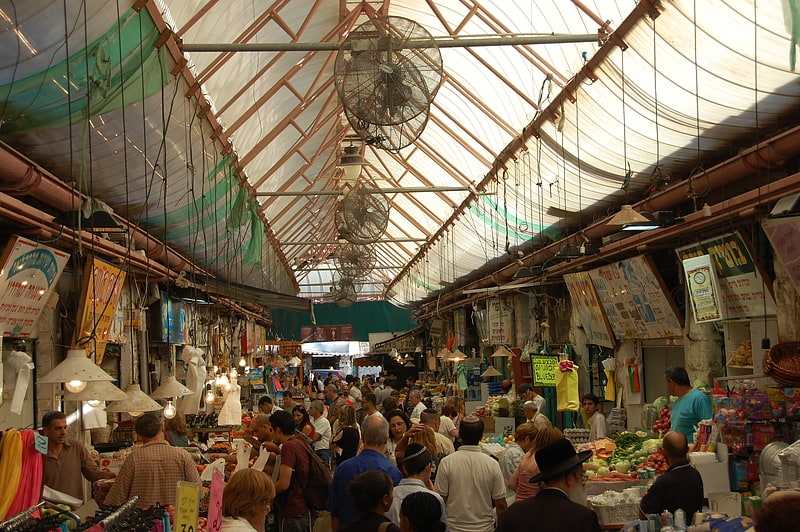
Also known as: שוק מחנה יהודה
Busy bazaar with lots of merchants. Mahane Yehuda Market, often referred to as "The Shuk", is a marketplace in Jerusalem. Popular with locals and tourists alike, the market's more than 250 vendors sell fresh fruits and vegetables; baked goods; fish, meat and cheeses; nuts, seeds, and spices; wines and liquors; clothing and shoes; and housewares, textiles, and Judaica.
In and around the market are falafel, shawarma, kibbeh, kebab, shashlik, kanafeh, baklava, halva, zalabiya and Jerusalem mixed grill stands, juice bars, cafes, and restaurants. The color and bustle of the marketplace is accentuated by vendors who call out their prices to passersby. On Thursdays and Fridays, the marketplace is filled with shoppers stocking up for Shabbat, until the Friday afternoon sounding of the bugle that signifies the market will close for the Sabbath. In recent years, the 'shuk' has emerged as another Jerusalemic nightlife center, with restaurants, bars and live music.[7]
Address: Rehov Mahane Yehuda, Jerusalem
Calvary

Also known as: גבעת הגולגולתא
Calvary, or Golgotha, was, according to the canonical Gospels, a site immediately outside Jerusalem's walls where Jesus was crucified.
The Gospels use the Koine term Kraníon (Κρανίον) or Kraniou topos (Κρανίου τόπος) when testifying to the place outside Jerusalem where Jesus was crucified. E.g. Mark 15:22 (NRSV), "Then they brought Jesus to the place called Golgotha (which means: 'the place of a skull')." 'Kraníon is often translated as 'skull' in English, but more accurately means cranium, the part of the skull enclosing the brain. In Latin, it is rendered Calvariae Locus, from which the English term Calvary derives.
Its traditional site, identified by Queen Mother Helena, mother of Constantine the Great, in 325, is at the site of the Church of the Holy Sepulchre. A 19th-century suggestion places it at the site now known as 'The Garden Tomb' on Skull Hill, some 500 m (1,600 ft) to the north, and 200 m (660 ft) north of the Damascus Gate. Historian Joan E. Taylor bases a location c. 175 m (574 ft) south-southeast of the traditional site on her reading of textual evidence.[8]
Israel Museum
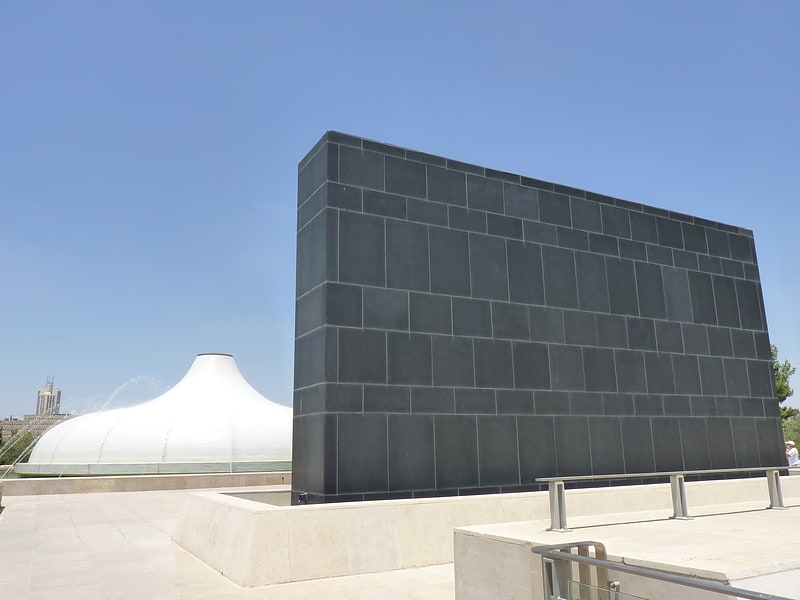
Also known as: מוזיאון ישראל
National art and archaeology museum. The Israel Museum is an art and archaeological museum in Jerusalem. It was established in 1965 as Israel's largest and foremost cultural institution, and one of the world’s leading encyclopaedic museums. It is situated on a hill in the Givat Ram neighborhood of Jerusalem, adjacent to the Bible Lands Museum, the Knesset, the Israeli Supreme Court, and the Hebrew University of Jerusalem.
Its holdings include the world’s most comprehensive collections of the archaeology of the Holy Land, and Jewish Art and Life, as well as significant and extensive holdings in the Fine Arts, the latter encompassing eleven separate departments: Israeli Art; European Art; Modern Art; Contemporary Art; Prints and Drawings; Photography; Design and Architecture; Asian Art; African Art; Oceanic Art; and Arts of the Americas.
Among the unique objects on display are the Venus of Berekhat Ram; the interior of a 1736 Zedek ve Shalom synagogue from Suriname; necklaces worn by Jewish brides in Yemen; a mosaic Islamic prayer niche from 17th-century Persia; and a nail attesting to the practice of crucifixion in Jesus’ time. An urn-shaped building on the grounds of the museum, the Shrine of the Book, houses the Dead Sea Scrolls and artifacts discovered at Masada. It is one of the largest museums in the region.[9]
Address: 11 Derekh Ruppin, 9543500 Jerusalem
Al-Aqsa Mosque
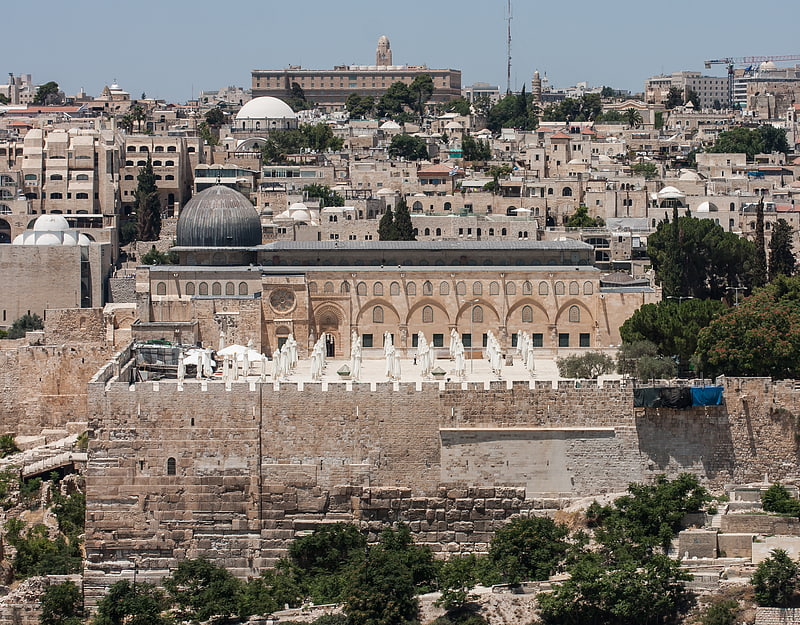
Also known as: מסגד אל-אקצא
Islamic mosque compound with silver dome. Al-Aqsa Mosque, located in the Old City of Jerusalem, is the third holiest site in Islam. The mosque was built on top of the Temple Mount, known as the Al Aqsa Compound or Haram esh-Sharif in Islam, several decades after Muhammad's death. Modern Muslims believe that Muhammad was transported from the Great Mosque of Mecca to this location during the Night Journey. Islamic tradition holds that Muhammad led prayers towards this site until the 16th or 17th month after his migration from Mecca to Medina, when Allah directed him to instead turn towards the Kaaba in Mecca.
The covered mosque building was originally a small prayer house erected by Umar, the second caliph of the Rashidun Caliphate, after the Muslim conquest of the Levant in the early 7th century. It was rebuilt and expanded by the Umayyad caliph Abd al-Malik and finished by his son al-Walid in 705. The mosque was completely destroyed by an earthquake in 746 and rebuilt by the Abbasid caliph al-Mansur in 754. It was rebuilt again in 780. Another earthquake destroyed most of al-Aqsa in 1033, but two years later the Fatimid caliph Ali az-Zahir built another mosque whose outline is preserved in the current structure. The mosaics on the arch at the qibla end of the nave also go back to his time.
During the periodic renovations undertaken, the various ruling dynasties of the Islamic Caliphate constructed additions to the mosque and its precincts, such as its dome, facade, its minbar, minarets and the interior structure. When the Crusaders captured Jerusalem in 1099, they used the mosque as a palace and the Dome of the Rock as a church. The structure was also the headquarters of the religious order of the Knights Templar. After the area was recaptured by Saladin in 1187, the structure's function as a mosque was restored. More renovations, repairs and additions were undertaken in later centuries by the Ayyubids, Mamluks, Ottomans, the Supreme Muslim Council, and Jordan. Today, the Old City is under Israeli control, but the mosque remains under the administration of the Jordanian/Palestinian-led Islamic Waqf.
The mosque is located in close proximity to historical sites significant in Judaism and Christianity, most notably the site of the Second Temple, the holiest site in Judaism. As a result, the area is highly sensitive, and has been a flashpoint in the Israeli–Palestinian conflict.[10]
Address: Temple Mount, Jerusalem
Church of All Nations
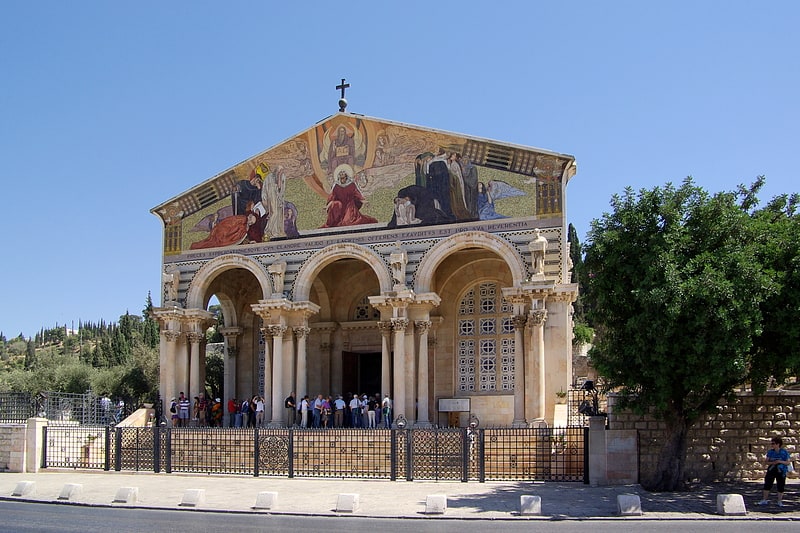
Also known as: כנסיית כל העמים
Basilica in Jerusalem. The Church of All Nations, also known as the Church or Basilica of the Agony, is a Roman Catholic church located on the Mount of Olives in East Jerusalem, next to the Garden of Gethsemane. It enshrines a section of bedrock where Jesus is said to have prayed before his arrest.[11]
Address: Garden of Gethsemane, Jerusalem
Tower of David
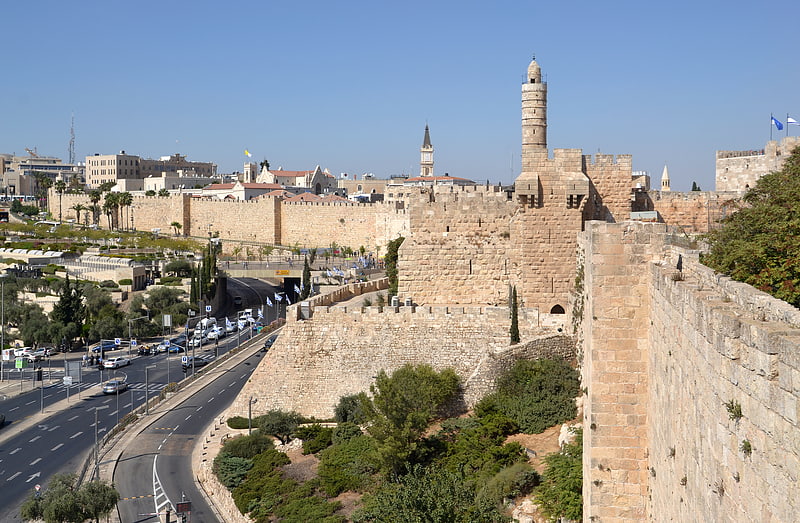
Also known as: מגדל דוד
History museum in Jerusalem. The Tower of David, also known as the Citadel, is an ancient citadel located near the Jaffa Gate entrance to the Old City of Jerusalem.
The citadel that stands today dates to the Mamluk and Ottoman periods. It was built on the site of a series of earlier ancient fortifications of the Hasmonean, Herodian, Byzantine and Early Muslim periods, after being destroyed repeatedly during the last decades of Crusader presence in the Holy Land by their Muslim enemies. It contains important archaeological finds dating back over 2,500 years including a quarry dated to the First Temple period, and is a popular venue for benefit events, craft shows, concerts, and sound-and-light performances.
Dan Bahat, the Israeli archeologist, writes that the original three Hasmonean towers standing in this area of the city were altered by Herod, and that "The northeastern tower was replaced by a much larger, more massive tower, dubbed the "Tower of David" beginning in the 5th century C.E." The name "Tower of David" migrated in the 19th century from the Herodian tower in the northeast of the citadel, to the 17th-century minaret at the opposite side of the citadel, and after 1967 has been officially adopted for the entire citadel.[12]
Address: Jaffa Gate, 9114001 Jerusalem
Mount of Olives
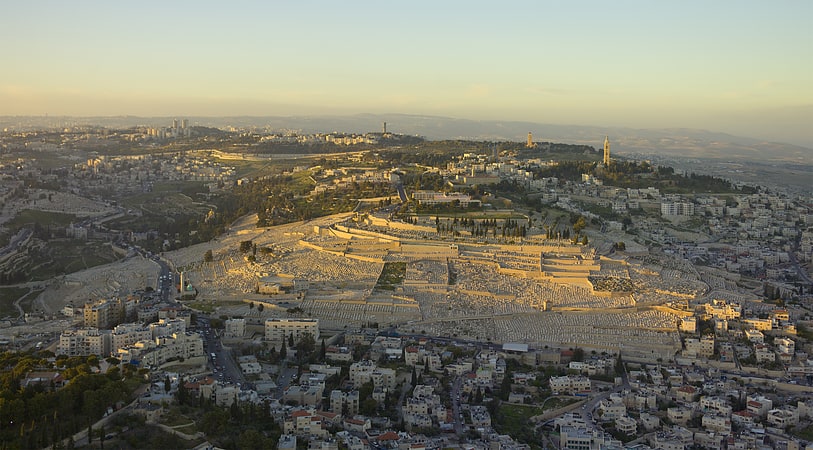
Also known as: הר הזיתים
Jerusalem's most iconic view. The Mount of Olives or Mount Olivet is a mountain ridge east of and adjacent to Jerusalem's Old City. It is named for the olive groves that once covered its slopes. The southern part of the mount was the Silwan necropolis, attributed to the ancient Judean kingdom. The mount has been used as a Jewish cemetery for over 3,000 years and holds approximately 150,000 graves, making it central in the tradition of Jewish cemeteries.
Several key events in the life of Jesus, as related in the Gospels, took place on the Mount of Olives, and in the Acts of the Apostles it is described as the place from which Jesus ascended to heaven. Because of its association with both Jesus and Mary, the mount has been a site of Christian worship since ancient times and is today a major site of pilgrimage for Catholics, the Eastern Orthodox, and Protestants.
Much of the top of the hill is occupied by At-Tur, a former village that is now a neighbourhood of East Jerusalem.[13]
Zedekiah's Cave
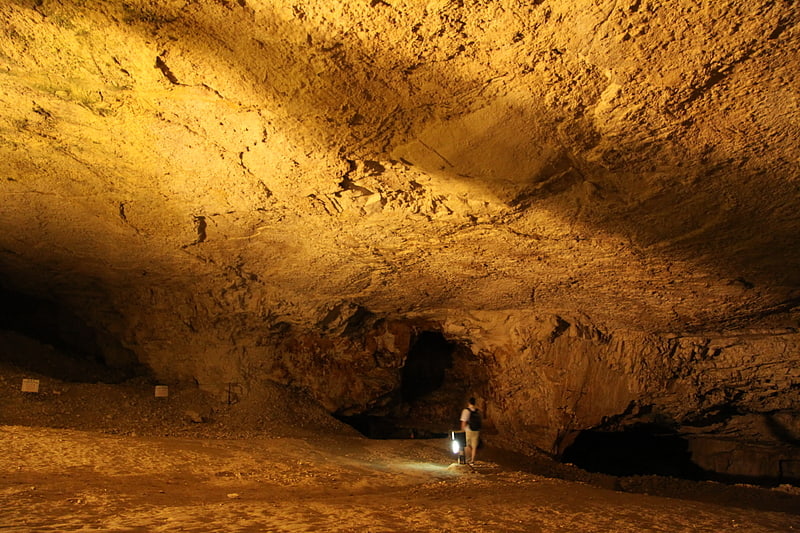
Also known as: מערת צדקיהו
Ancient subterranean quarry with tours. Zedekiah's Cave—also called Solomon's Quarries—is a 5-acre underground meleke limestone quarry that runs the length of five city blocks under the Muslim Quarter of the Old City of Jerusalem. It was carved over a period of several thousand years and is a remnant of the largest quarry in Jerusalem, stretching from Jeremiah's Grotto and the Garden Tomb to the walls of the Old City. The cave has great historical importance in Freemasonry.
The cave is open to the public Sunday through Thursday for an admission fee and there are guided tours.[14]
Address: Near Damascus Gate., Jerusalem
Menorah

Also known as: המנורה
The Menorah is described in the Hebrew Bible as a seven-branched candelabrum used in the Tabernacle and in the Temple in Jerusalem. The menorah has been a symbol of the Jewish people and Judaism both in the Land of Israel and the Diaspora since antiquity, and is depicted on the national emblem of the modern State of Israel.
According to the Hebrew Bible, the menorah was made out of pure gold, and fresh olive oil was burned daily to light its lamps. Biblical tradition holds that Solomon's Temple was home to ten menorahs, which were later taken away by the Babylonians. A menorah also stood in the Second Temple. Following the destruction of Jerusalem by the Romans in 70 CE, the menorah was taken to Rome; the Arch of Titus, which still stands today, famously depicts the menorah being carried away along by the triumphant Romans along with other spoils of the temple. Traces of the temple menorah has been lost to time since Late Antiquity.
Representations of the temple menorah have been discovered on Jewish tombs and monuments dating from the first century. As a symbol, the menorah has been used since then to distinguish Jewish synagogues and cemeteries from those of Christians and pagans. The Hanukkah menorah (Hanukkiah in Modern Hebrew), a nine-branched variant, is closely associated with the Jewish holiday of Hanukkah.[15]
Museum for Islamic Art
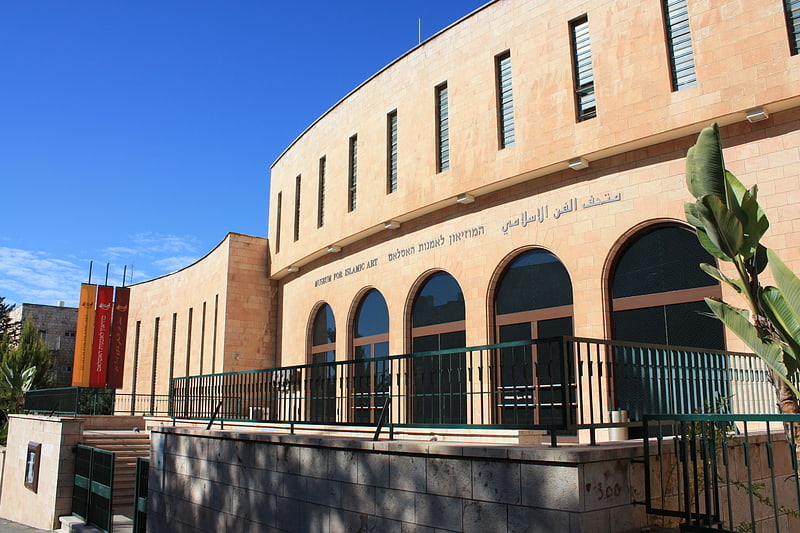
Also known as: המוזיאון לאמנות האסלאם
Museum in Jerusalem, Israel. The Museum for Islamic Art is a museum in Jerusalem, established in 1974. Located on the corner of HaPalmach Street in Katamon, down the road from the Jerusalem Theater, it houses Islamic pottery, textiles, jewelry, ceremonial objects and other Islamic cultural artifacts.[16]
Address: 2 Ha-Palmakh, 9254202 Jerusalem
Tomb of the Virgin Mary

Also known as: קבר מרים
Revered tomb of the Virgin Mary. Church of the Sepulchre of Saint Mary, also Tomb of the Virgin Mary, is a Christian tomb in the Kidron Valley – at the foot of Mount of Olives, in Jerusalem – believed by Eastern Christians to be the burial place of Mary, the mother of Jesus. The Status Quo, a 250-year old understanding between religious communities, applies to the site.[17]
Western Wall Tunnel
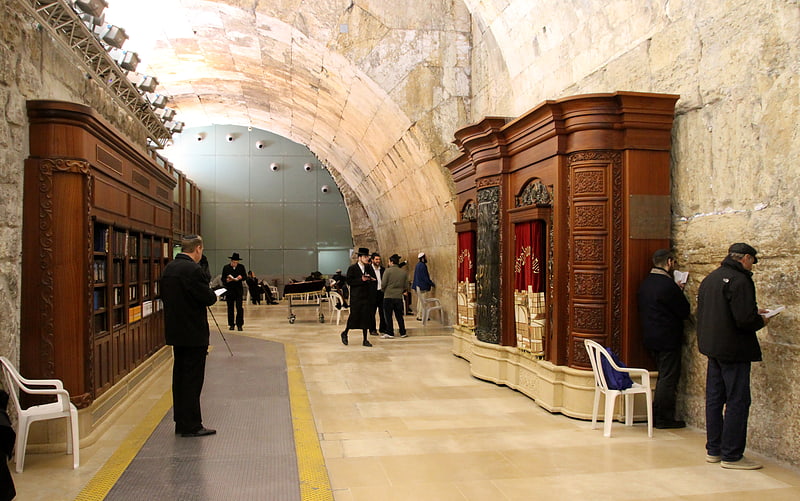
Also known as: מנהרות הכותל
The Western Wall Tunnel is a tunnel exposing the Western Wall from where the traditional, open-air prayer site ends and up to the Wall's northern end. Most of the tunnel is in continuation of the open-air Western Wall and is located under buildings of the Muslim Quarter of the Old City of Jerusalem. While the open-air portion of the Western Wall is approximately 60 metres long, the majority of its original length of 488 metres is hidden underground. The tunnel allows access to the remainder of the Wall in a northerly direction.[18]
Address: Old City, Jerusalem
Shrine of the Book
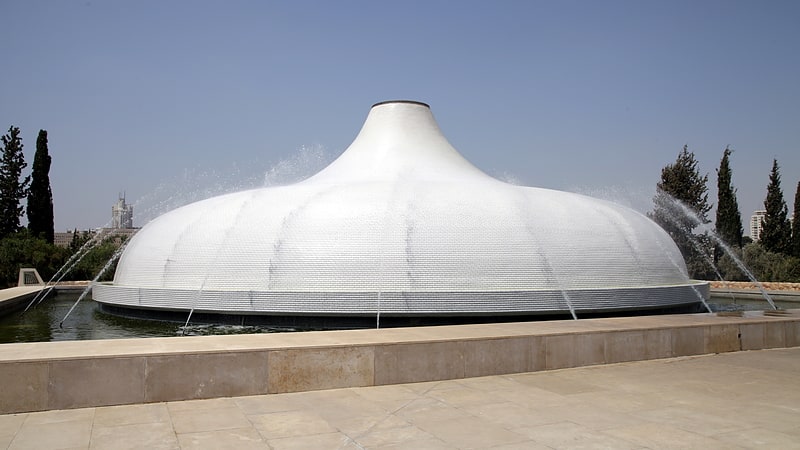
Also known as: היכל הספר
Museum in Jerusalem, Israel. The Shrine of the Book is a wing of the Israel Museum in the Givat Ram neighborhood of Jerusalem that houses the Dead Sea Scrolls.[19]
Address: Derekh Ruppin, 9543500 Jerusalem
Mount Zion Cemetery
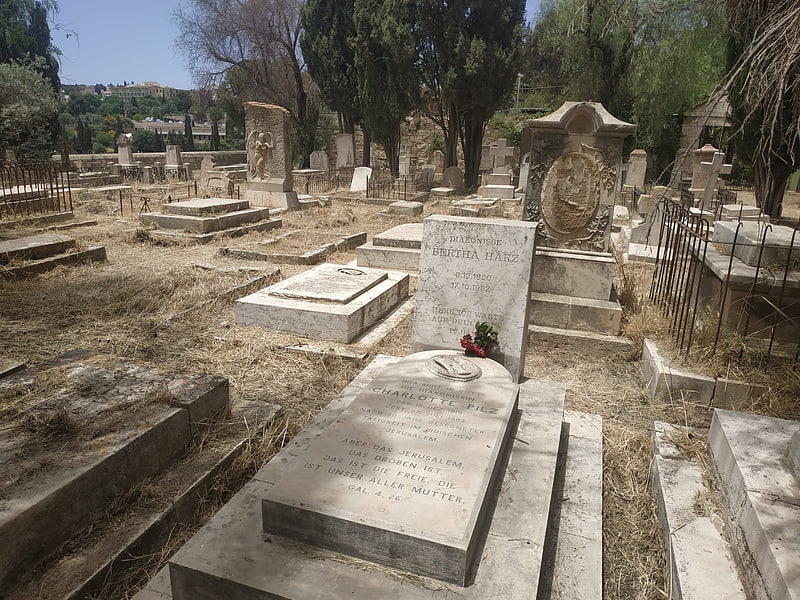
Cemetery in Jerusalem, Israel. The Protestant Mount Zion Cemetery on Mount Zion in Jerusalem, is a cemetery owned by the Anglican Church Missionary Trust Association Ltd., London, represented by the Episcopal Church in Jerusalem and The Middle East. In 1848 Samuel Gobat, Bishop of Jerusalem, opened the cemetery and dedicated it as ecumenical graveyard for congregants of Anglican, Lutheran, Reformed and old Catholic faith. Since its original beneficiary, the Bishopric of Jerusalem was maintained as a joint venture of the Anglican Church of England and the Evangelical Church in Prussia, a united Protestant Landeskirche of Lutheran and Reformed congregations, until 1886, the Jerusalem Lutheran congregation preserved a right to bury congregants there also after the Jerusalem Bishopric had become a solely Anglican diocese.[20]
Dominus Flevit Church
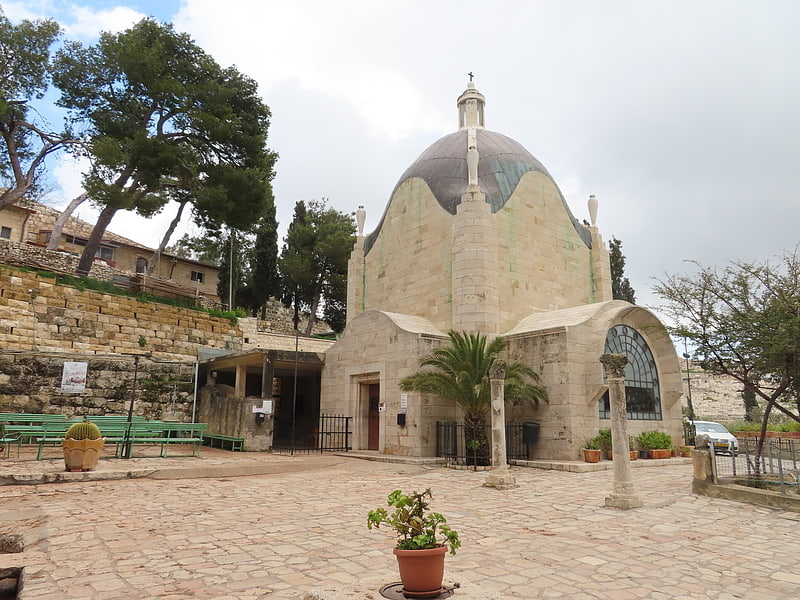
Also known as: כנסיית דומינוס פלוויט
Catholic sanctuary church built in 1955. Dominus Flevit is a Roman Catholic church on the Mount of Olives, opposite the walls of the Old City of Jerusalem. During construction of the sanctuary, archaeologists uncovered artifacts dating back to the Canaanite period, as well as tombs from the Second Temple and Byzantine eras.[21]
Address: Mount of Olives, Jerusalem
Hurva Synagogue
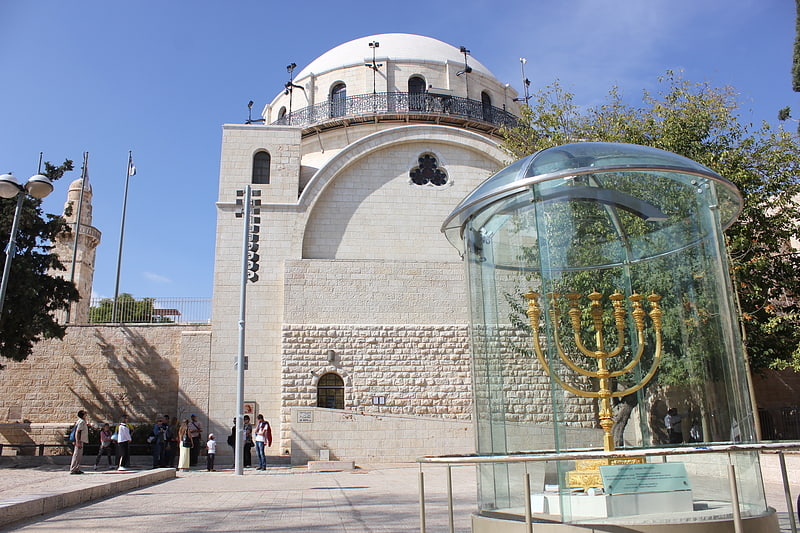
Also known as: בית הכנסת החורבה
Synagogue in Jerusalem. The Hurva Synagogue, also known as Hurvat Rabbi Yehudah he-Hasid, is a historic synagogue located in the Jewish Quarter of the Old City of Jerusalem.
It was originally founded in the early 18th century by followers of Judah HeHasid on the ruins of a 15th century synagogue and adjacent to the 14th century Sidna Omar mosque, but was destroyed a few years later in 1721 by Ottoman authorities, for failure of its proprietors to pay back a debt to local Muslims. The plot became known as "The Ruin", or Hurva, where it lay desolate for 116 years until it was resettled in 1837 by members of the Ashkenazi Jewish community, known as the Perushim. In 1864, the Perushim rebuilt the synagogue, and although officially named the Beis Yaakov Synagogue, it retained its name as the Hurva. It became Jerusalem's main Ashkenazi synagogue, until it too was destroyed by the Arab Legion during the fighting in the 1948 Arab–Israeli War.
After Israel captured East Jerusalem from Jordan in 1967, a number of plans were submitted for the design of a new building. After years of deliberation and indecision, a commemorative arch was erected instead at the site in 1977, itself becoming a prominent landmark of the Jewish Quarter. The plan to rebuild the synagogue in its 19th-century style received approval by the Israeli Government in 2000, and the newly rebuilt synagogue was dedicated on March 15, 2010.[22]
Address: 89 Ha-Yehudim, 9751909 Jerusalem
Cenacle
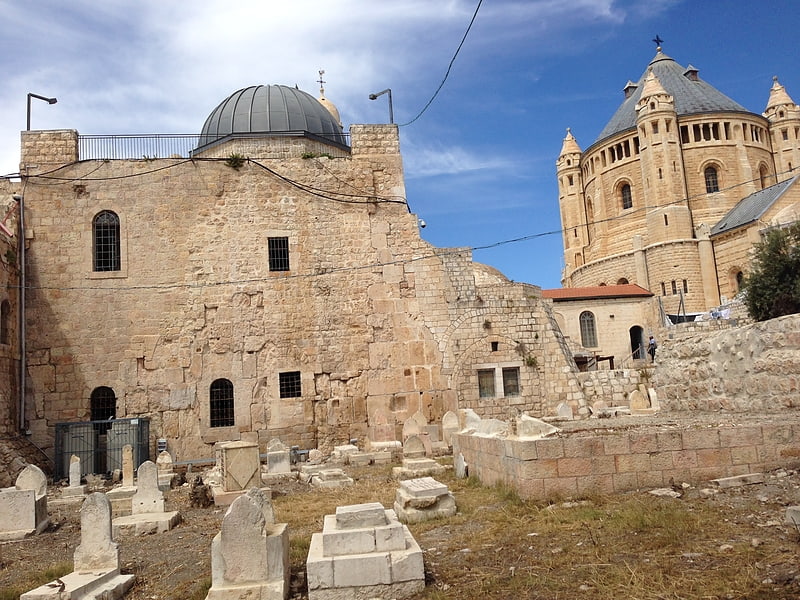
Also known as: חדר הסעודה האחרונה
Tourist attraction in Jerusalem, Israel. The Cenacle, also known as the Upper Room, is a room in Mount Zion in Jerusalem, just outside the Old City walls, traditionally held to be the site of the Last Supper, the final meal that, in the Gospel accounts, Jesus held with the apostles.
According to the Christian Bible, the Cenacle was a place in which the apostles continued to gather after the Last Supper, and it was also the site where the Holy Spirit alighted upon the eleven apostles on Pentecost.
The site is administered by Jewish authorities, who renamed the compound "David's Tomb", even though there is a consensus among historians, scholars and Jewish religious authorities that this was not the place of burial of Biblical King David.[23]
Address: Mount Zion, Jerusalem
Damascus Gate
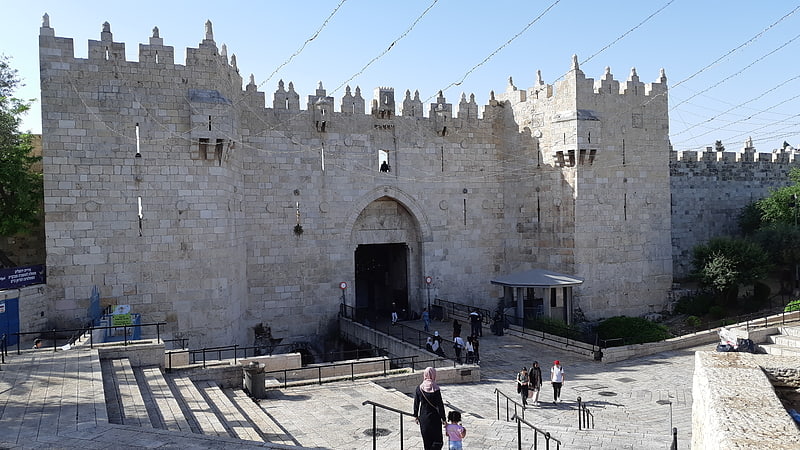
Also known as: שער שכם
Entrance to the Old City of Jerusalem. The Damascus Gate is one of the main Gates of the Old City of Jerusalem. It is located in the wall on the city's northwest side and connects to a highway leading out to Nablus, which in the Hebrew Bible was called Shechem or Sichem, and from there, in times past, to the capital of Syria, Damascus; as such, its modern English name is the Damascus Gate, and its modern Hebrew name, Sha'ar Shkhem, meaning Shechem Gate, or in modern terms Nablus Gate. Of its historic Arabic names, Bab al-Nasr means "gate of victory", and Bab al-Amud means "gate of the column". The latter name, in use continuously since at least as early as the 10th century, preserves the memory of a Roman column towering over the square behind the gate and dating to the 2nd century AD.[24]
Address: 17 Sultan Suleiman, 9761190 Jerusalem
Church of the Visitation
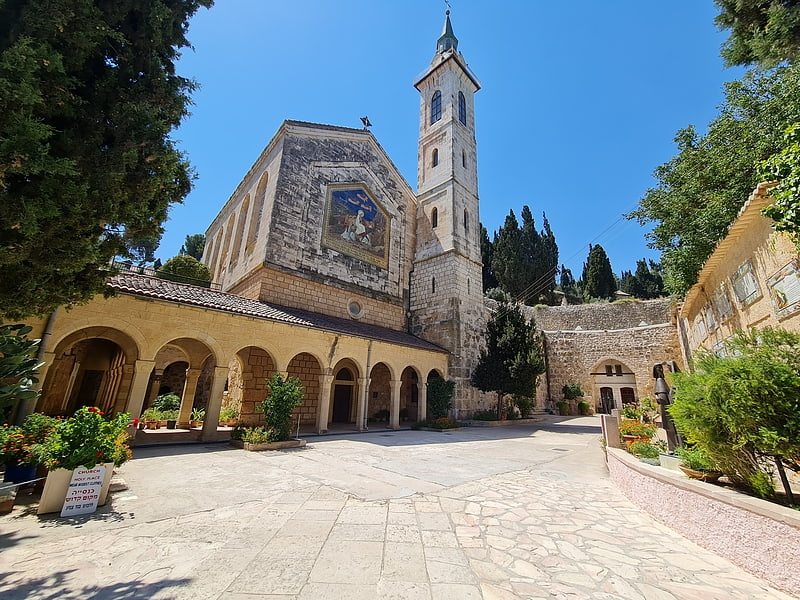
Also known as: כנסיית הביקור
Catholic church with link to Virgin Mary. The Church of the Visitation is a Catholic church in Ein Karem, Jerusalem, and honors the visit paid by the Virgin Mary, the mother of Jesus, to Elizabeth, the mother of John the Baptist. This is the site where tradition tells us that Mary recited her song of praise, the Magnificat, one of the most ancient Marian hymns.[25]
Siebenberg House
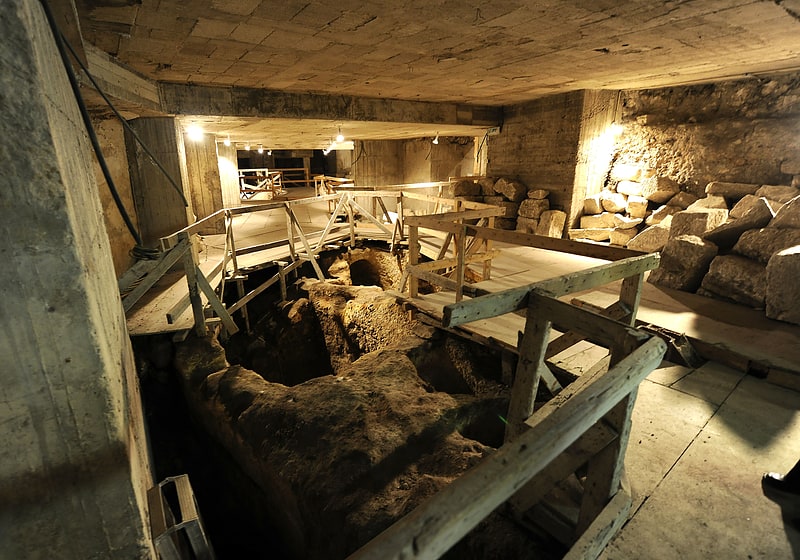
Museum in Jerusalem. Siebenberg House is a museum below a house on 5 Beit HaShoeva Alley in the Old City of Jerusalem in the Jewish Quarter.
The founder of the museum, Theo Siebenberg, moved to the Old City of Jerusalem in 1970 and started excavating underneath his home in order to fulfill his lifelong dream of finding an inextricable link between the Jerusalem of today and the Jerusalem of nearly three thousand years ago.
The excavations carried out underneath the Siebenberg home in the course of 18 years have revealed remains of ancient dwellings, rooms cut from rock, mikvahs (ritual baths) an aqueduct, two huge cisterns and a burial vault, reaching back 3,000 years to the days of King David and the First Temple period, as well as from the Second Temple period. It also shows artifacts, including pottery, glass, mosaics, coins, jars and weapons.[26]
Address: 5 Beit ha-Sho'eva, 9751722 Jerusalem
Knesset Menorah

Also known as: מנורת הכנסת
Government office in Jerusalem, Israel. The Knesset Menorah is a bronze Menorah 4.30 meters high, 3.5 meters wide, and weighs 4 tons. It is located at the edge of Gan Havradim opposite the Knesset. It was designed by Benno Elkan, a Jewish sculptor who escaped from his native Germany to Britain. It was presented to the Knesset as a gift from the Parliament of the United Kingdom on April 15, 1956 in honour of the eighth anniversary of Israeli independence.
The Knesset Menorah was modelled after the golden candelabrum that stood in the Temple in Jerusalem. A series of bronze reliefs on the Menorah depict the struggles to survive of the Jewish people, depicting formative events, images and concepts from the Hebrew Bible and Jewish history. The engravings on the six branches of the Menorah portray episodes since the Jewish exile from the Land of Israel. Those on the central branch portray the fate of the Jews from the biblical return to the Land to the establishment of the modern State of Israel. It has been described as a visual "textbook" of Jewish history.[27]
Church of Saint Peter in Gallicantu
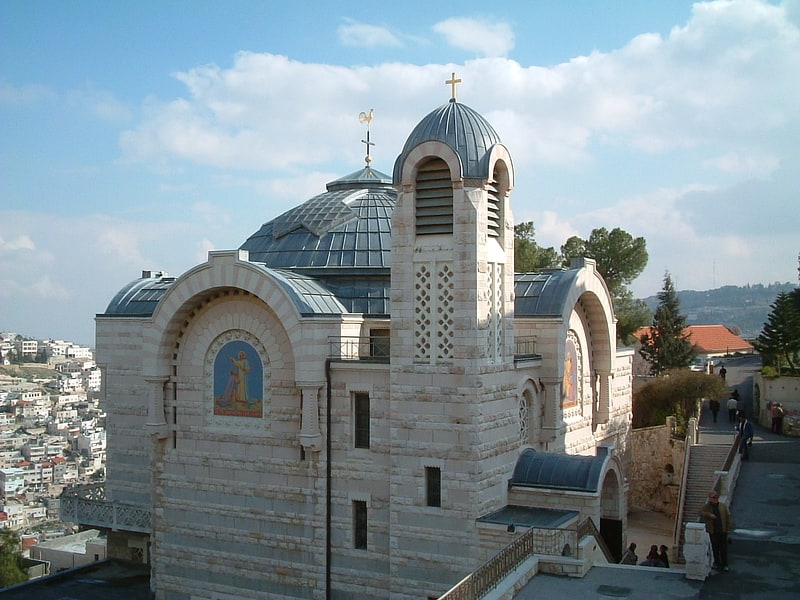
Also known as: כנסיית פטרוס אין גליקנטו
Church in Jerusalem. Church of Saint Peter in Gallicantu is a Roman Catholic church located on the eastern slope of Mount Zion, just outside the Old City of Jerusalem.[28]
Address: Village of Silwan, Jerusalem
City of David

Also known as: עיר דוד
Historical place museum in Jerusalem. The City of David is a historic name given to an archaeological site on the southeast hill of contemporary East Jerusalem, which is thought to constitute the original settlement core of Jerusalem during the Bronze Age and Iron Ages.
The site is believed to be the former royal city of the Israelite king David, from whom it takes its name, and is a holy site for Jews, Christians and Muslims. Parts of the ancient city were exposed in archaeological excavations conducted at the site, and today are part of the Jerusalem Walls National Park.[29]
Pool of Bethesda
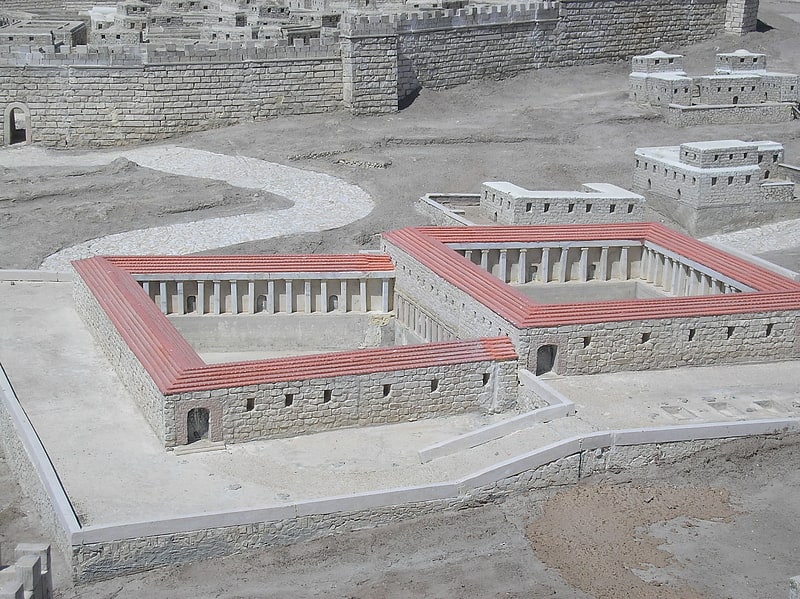
Also known as: בריכות הצאן
Archaeological museum in Jerusalem, Israel. The Pool of Bethesda is a pool in Jerusalem known from the New Testament account of Jesus miraculously healing a paralysed man, from the fifth chapter of the Gospel of John, where it is described as being near the Sheep Gate, surrounded by five covered colonnades or porticoes. It is now associated with the site of a pool in the current Muslim Quarter of the city, near the gate now called the Lions' Gate or St. Stephen's Gate and the Church of St. Anne, that was excavated in the late 19th century.[30]
Church of the Pater Noster
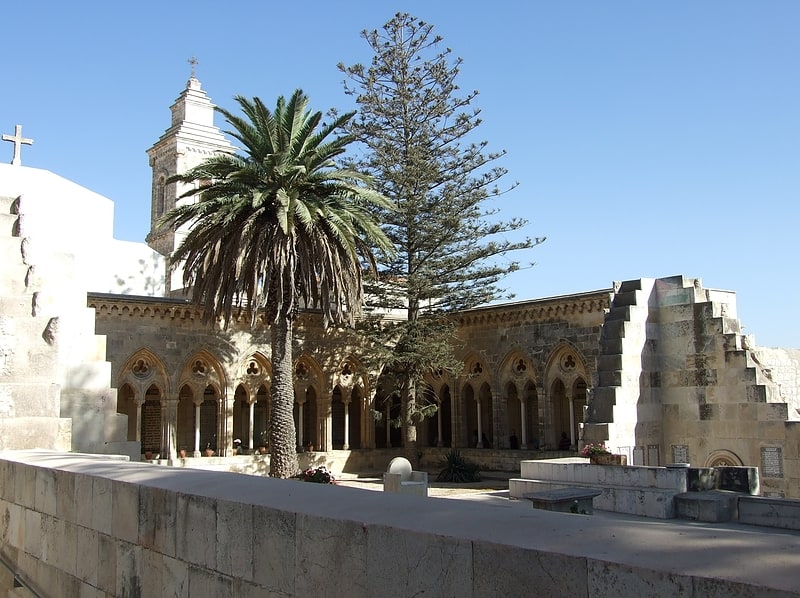
Also known as: כנסיית אבינו שבשמים
Church in Jerusalem. The Church of the Pater Noster is a Roman Catholic church located on the Mount of Olives in Jerusalem. It is part of a Carmelite monastery, also known as the Sanctuary of the Eleona. The Church of the Pater Noster stands right next to the ruins of the 4th-century Byzantine Church of Eleona. The ruins of the Eleona were rediscovered in the 20th century and its walls were partially rebuilt. Today, France claims ownership of the land on which both churches and the entire monastery are standing under the Ottoman capitulations and further it claims the land as a French Domaine national which has been formalised by the Fischer-Chauvel Agreement of 1948, though the agreement has not been ratified by Israel’s Knesset.[31]
Address: Mount of Olives, Jerusalem
Rockefeller Archeological Museum
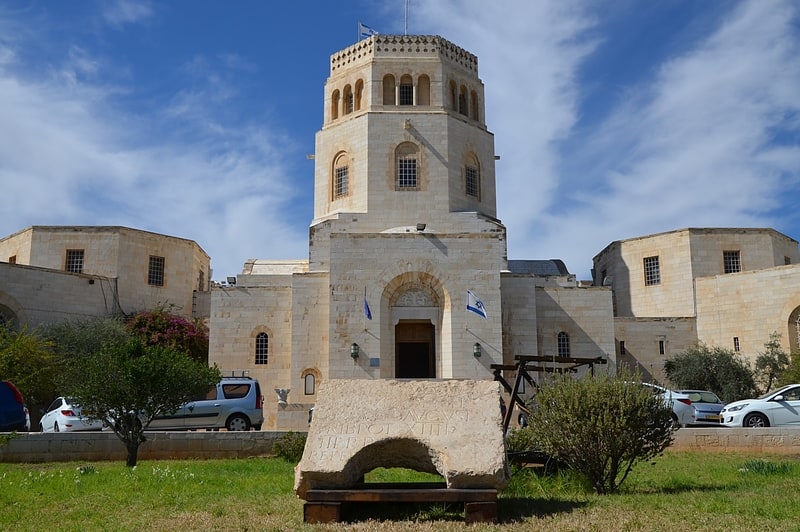
Also known as: מוזיאון רוקפלר
Trove of Israeli antiques and artifacts. The Rockefeller Archeological Museum, formerly the Palestine Archaeological Museum, is an archaeology museum located in East Jerusalem that houses a large collection of artifacts unearthed in the excavations conducted in Mandatory Palestine, in the 1920s and 1930s.
The museum is under the management of the Israel Museum and houses the head office of the Israel Antiquities Authority.[32]
Address: 27 סולטאן סולימאן, 9761190 שלם
Golden Gate

Also known as: שער הרחמים
Historical place in Jerusalem. The Golden Gate or Gate of Mercy is the only eastern gate of the Temple Mount, and one of only two Gates of the Old City of Jerusalem that used to offer access into the city from the East side.
The gate has been sealed since medieval times. Its interior can be accessed from the Temple Mount. It was recently converted into a mosque.
In Jewish tradition, the Messiah will enter Jerusalem through this gate. Christians and Muslims generally believe that this was the gate through which Jesus entered Jerusalem.[33]
Monument to the children in Yad Vashem
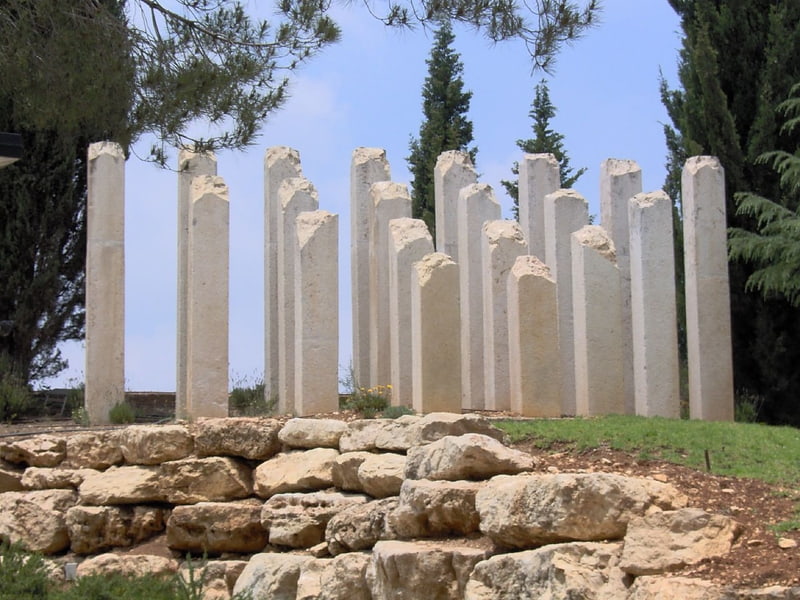
Cultural center in Jerusalem, Israel. The Monument to the children in Yad Vashem is located at Yad Vashem, Israel. It was erected in 1987 in remembrance of children killed during the reign of the Nazi Party in the German Reich.
In the memorial's entrance area, there are several white, broken-off stelae of different heights as a symbol for the lives broken off by the Nazis.
The main room of the memorial is completely mirrored and reflects the light of five candles.
The reflection of these lights produces the illusion of space, which symbolizes the approximately 1.5 million children and young people who died during the Holocaust.
As spectators move through the room in the sparse light of the candles, names of the deceased children and adolescents, with their age and place of death, are recited by a looped tape recording. The recording takes about three months to list all the casualties.
The name of the monument, Yad Vashem (Hebrew יד ושם for "monument and name"), comes from Isaiah 56:5, Luther Bible: "To all of them I erect a monument in my house and in my walls, I give them a name worth more than sons and daughters: I give them an eternal name that will never be erased".[34]
Southern Wall
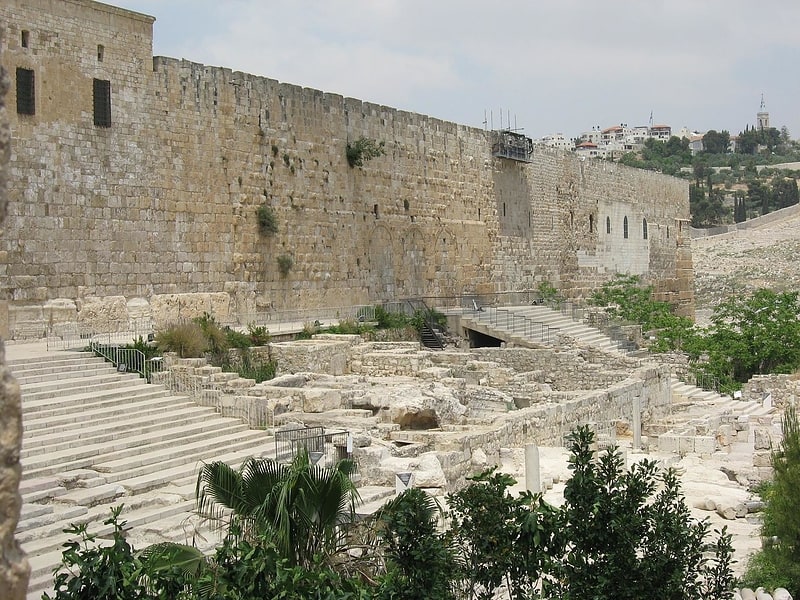
Also known as: הכותל הדרומי
Historical landmark in Jerusalem. The Southern Wall is a wall at the southern end of the Temple Mount and the former southern side of the Second Temple in Jerusalem. It was built during King Herod's expansion of the Temple Mount platform southward on to the Ophel.[35]